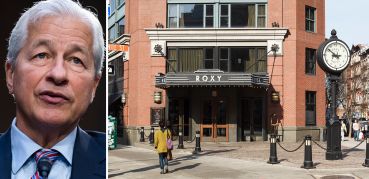Private CRE Lenders Forecast Partly Cloudy Future as Morgan Stanley Warns of Hail
By Brian Pascus April 5, 2023 5:04 pm
reprints
As various storm clouds and negative headlines surround the future of commercial real estate, private lenders remain optimistic that the industry won’t face the same reckoning as it did 15 years ago.
“There’s just so much more money now in real estate than there was during the Global Financial Crisis (GFC),” said David Perlman, managing director of Thorofare Capital, a CRE debt fund. “I do think prices will come down and commercial real estate will be hit hard, but I also think there are ways to make money in this cycle. People are still making investments and bidding on loans for good deals.”
Perlman cited the recent upcoming sale from Newmark of more than $60 billion of loans originated by the recently failed Signature Bank — including its entire CRE loan portfolio — as evidence of opportunities for capital to find quality investment in a beleaguered industry.
“People are super excited about the Signature Bank (SBNY) portfolio sale, and I don’t think anyone won’t bid on that,” he said. “When you have a bidding market, you tend to overbid and overpay for things.”
Manish Shah, senior managing director at Palladius Capital Management, a real estate investment firm, emphasized that the current economic upheaval in no way resembles the dark days of 2008 and 2009.
“Will there be people that have bad business plans, will there be people that over-leveraged, and maybe will there be weak lenders that have to go out of the system? Yes. But as an aggregate crisis, it’s just not that big of a crisis,” Shah said.
“The scale is nowhere near the GFC,” Shah added. “[That] was about the financial institutions themselves, up and down the stack, who were overleveraged and had correlated risk issues.”
The pushback from private lenders on the doom and gloom scenarios came after Morgan Stanley (MS) Chief Investment Officer Lisa Shalett published a new report April 3 that forecasts CRE price declines at least 40 percent worse than the GFC.
Shalett’s report suggests widespread CRE price declines could infect the entire financial system.
Morgan Stanley analysts “forecast a peak-to-trough CRE price decline of as much as 40 percent, worse than in the Great Financial Crisis,” wrote Shalett. “Distress of this type has historically not only hurt the landlords and the bankers who lend to them, but also the interconnected business communities, private capital funders and owners of any underlying securitized debt.”
Shalett’s report, titled “Not a Port in the Storm,” emphasized the dangers posed from the annual decline of CRE prices as office vacancies have nearly reached a 20-year high; the report noted these two phenomena are linked to the expectation that more than 50 percent of $1.9 trillion in outstanding CRE mortgage debt will come due over the next 24 months — and after interest rates have increased to nearly 5 percent since many of those loans were originated.
“Commercial real estate, already facing headwinds from a shift to hybrid/remote work, has to refinance more than half of its mortgage debt in the next two years,” Shalett wrote. “The commercial real estate market is vulnerable to any adverse developments in interest rates or bank lending.”
Shalett’s forecast is backed up by some discouraging data.
A February 2023 report from MSCI Real Assets, a data research firm, found that CRE asset prices declined together with deal volume for every sector but retail in 2022. Office transaction volume was down 66 percent year-over-year; industrial transaction volume fell 52 percent; hotel transaction volumes declined by 53 percent; and multifamily apartment transaction volume fell by 73 percent, according to MSCI data.
As price declines continue to impact nearly every asset class, the ability for institutional capital to come to the rescue could be hindered by higher interest rates and less liquidity, according to MSCI. “Borrowers looking to refinance in the near term may well be met with higher capital costs, fewer willing lenders and more conservative lending terms,” wrote Jim Costello, chief economist at MSCI.
But private lenders like Shah and Perlman said they expect private capital to pick up the slack from a vulnerable banking system, which has seen Silicon Valley Bank, Signature Bank, Credit Suisse (and nearly First Republic Bank) all fail in the last month.
“Private credit doesn’t have a duration mismatch with its liabilities and assets, private credit isn’t over-leveraged,” Shah said. “In fact, it’s barely levered compared to a regional bank, and there’s a lot of it. This rise in private credit means in the cases when you do have to have a recapitalization, private credit is there.”
Perlman concurred on this point and said debt funds are prepared to deploy capital.
“There definitely will be some pain on [the] assets, but there’s a lot of capital that can take this stuff off the books,” Perlman said. “I think a lot of lenders are open to extending short-term loans for another year and hoping the yield curve goes down.
“It’s a kicking-the-can-down-the-road phenomenon,” he added.
But some economists are not as confident about the state of CRE in an increasingly vulnerable economy.
Tomasz Piskorski, professor of finance at Columbia Business School, pointed out that CRE currently faces four unprecedented headwinds: office loan delinquencies are increasing and the vacancy rate across the sector is reaching all-time highs; COVID-era hybrid work has permanently altered office space utilization; a recession in the technology sector has resulted in tens of thousands of layoffs nationwide; and the banking sector faces a potential credit crunch after accumulating $2.2 trillion in unrealized losses over the past year.
“This is a perfect storm. We really have never seen this,” Piskorski said. “Usually you have one or two of the factors, but not all of them working together, especially with higher interest rates.”
On the same note, Lawrence J. White, professor of economics at NYU’s Stern School of Business, said the current economic conditions reminded him of the wave of bank failures during the 1980s and early 1990s, when more than 1,600 banks folded or needed FDIC financial assistance between 1980 and 1994.
Total real estate loans of banks more than tripled during the 1980s, and commercial real estate loans nearly quadrupled, according to a 1998 FDIC report. As a percentage of total bank assets, total commercial real estate loans rose from 18 to 27 percent between 1980 and 1990, while the ratio for nonresidential and construction loans nearly doubled, from 6 to 11 percent, according to the FDIC.
“A major cause for their failures was over-investment in [commercial] real estate,” White recalled. “I’m not sure what it is about commercial mortgages that causes bankers to be less careful and overextend themselves, but they do.”
Brian Pascus can be reached at bpascus@commercialobserver.com.


